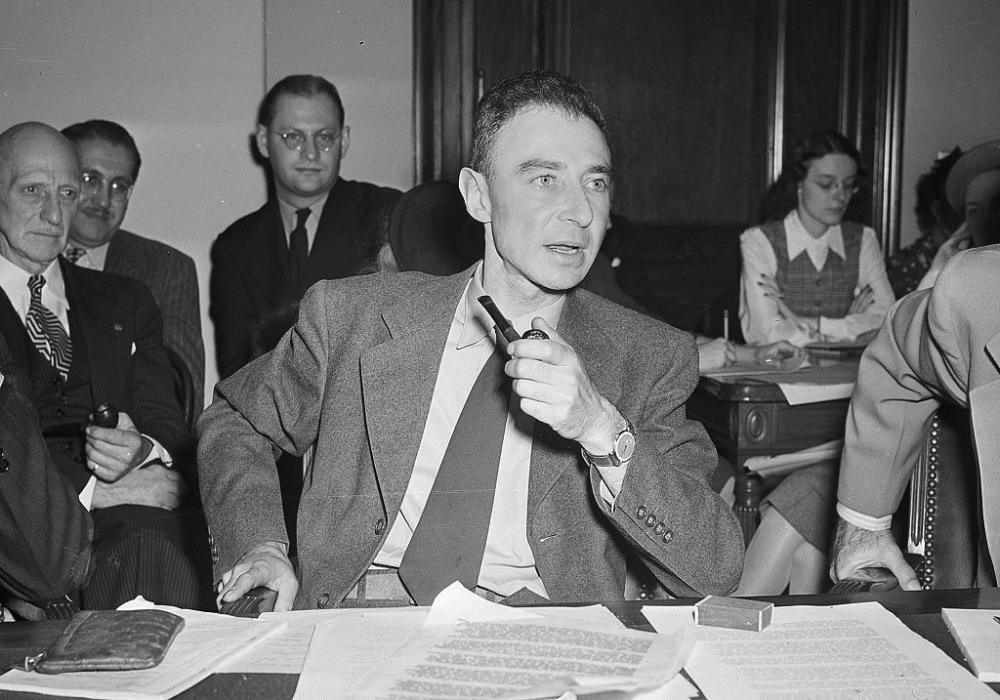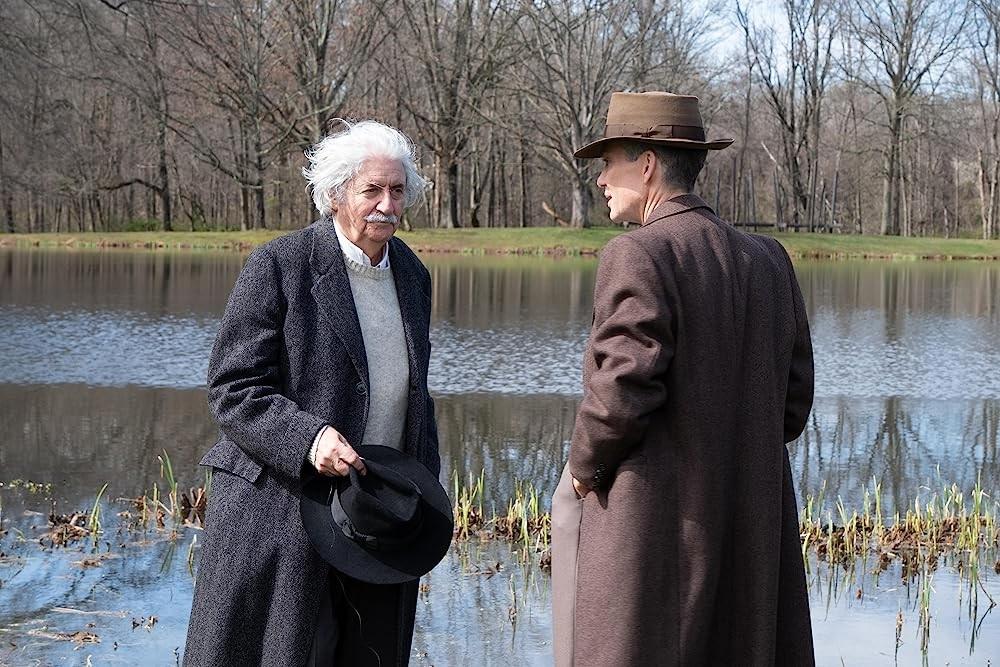Atomic Frankenstein

Christopher Nolan’s Oppenheimer is historically and dramatically rich, morally complex, psychologically sophisticated, epically grand, visually stunning, perfectly paced with a heart-stopping soundtrack, extraordinarily well cast and acted—a wondrous blend of science, politics, psychology, and art. It may garner almost as many Oscars as there were Nobel Prize winners among the myriad scientists working under J. Robert Oppenheimer on the Manhattan District Project in the race to produce an atom bomb between the spring of 1942 and summer of 1945, when the two bombs dropped on Hiroshima and Nagasaki ended World War II.
In keeping with Nolan’s fascination with the fungibility of time, Oppenheimer moves fluidly between four time periods: the protagonist’s (Cillian Murphy) early adulthood when he was a student at Cambridge and Göttingen, and then a young professor at UC Berkeley; the war years spent at Los Alamos, New Mexico; the excruciating hearings of a special board convened by the Atomic Energy Commission during the McCarthy era to examine the father of the atom bomb’s loyalty to the U.S., which ended in the devastating removal of his security clearance; and the confirmation hearings in 1959 to consider the appointment of Lewis Strauss (Robert Downey Jr.) as Eisenhower’s secretary of commerce. Strauss (pronounced “Straws”), a prominent member of the AEC despite the lack of a college education, had appointed Oppenheimer as director of the Institute for Advanced Study at Princeton after the war, yet Oppenheimer had later publicly humiliated Strauss in congressional hearings about nuclear policy. The man in high office with no credentials had come to hate the world’s most famous scientist.
The splitting of the atom serves as rich metaphor for the splitting of a mind, of a personality, of consciousness, and of ethical conscience.
Oppenheimer is a cubist movie, both in its fraught relation to color and in Nolan’s weaving of disparate planes of time associatively into scenes that represent the feelings, conscious and unconscious, of what it must have felt like to be Oppenheimer in a world that, as in a Greek tragedy, first worshipped and then crushed him. At one point early in the film, the young Oppenheimer gazes for a remarkably long time at Picasso’s 1937 contorted painting “Woman Seated With Crossed Arms,” while reading Eliot’s “The Waste Land.” Nolan evokes other icons of modernity—Stravinsky and Freud, and Einstein, brilliantly played by Tom Conti. The father of relativity hovers, in several pointed exchanges with Oppenheimer, like a tutelary Moses who has led the way, not only scientifically but also by alerting Roosevelt to the possibility of an atom bomb, yet who will not make it fully into the atomic age. The Mosaic resonance is amplified when Oppenheimer consults Einstein about Edward Teller’s (Benny Safdie) calculations that an atom bomb might ignite the atmosphere and asks him what to do if Teller’s theory proves correct. Einstein answers: You stop. You go no further.
Nolan bases his film on Martin Sherwin and Kai Bird’s 2005 Pulitzer Prize-winning biography of Oppenheimer American Prometheus. But the film, which makes the book come alive, departs from it in important ways. Nolan answers the question that haunts the book: Why, given Oppenheimer’s psychological instability and his propensity for surrounding himself with Communists in the 1930s, did Gen. Leslie Groves (Matt Damon) select him to direct what was then the world’s most important scientific project and potentially the key to U.S. victory in World War II? Never mind that Oppenheimer had never run even so much as a single scientific laboratory. For starters, Nolan focuses dramatically on Oppenheimer’s attempt to poison his Cambridge adviser Patrick Blackett (James D’Arcy) by injecting potassium cyanide into an apple left on the teacher’s desk. Later, when asked whether he hated Blackett, Oppenheimer unforgettably says no; he liked him. Even before this, when asked whether he was happy at school, Oppenheimer answers no; and in flashbacks characteristic of Nolan’s cinematography, we see him roiling in bed tormented by nightmares in which galaxies seem to be exploding and splintering—dreams that foreshadow the fragmentations to come. Above all, Nolan drives home Oppenheimer’s status as fellow traveler. His brother Frank (Dylan Arnold) and sister-in-law Jackie (Emma Dumont), his best friend at Berkeley Haakon Chevalier (Jefferson Hall), one of his girlfriends Jean Tatlock (Florence Pugh), many of his graduate students, and his wife Kitty (Emily Blunt) were all card-carrying members of the Party. Oppenheimer himself espoused leftist causes, from the Spanish Civil War to the organization of a Bay Area teachers union. The FBI garnered all this, as we are shown in what now seem like quaint scenes of physical surveillance: tracking of license plates at local gatherings in support of radical causes, the tapping of Oppenheimer’s phone, and the clunky sifting through his garbage. (This was the basis of part of the file used against him in the 1954 hearing before the AEC.)

J. Robert Oppenheimer testifies before the Senate Military Affairs Committee in Washington, October 17, 1945. AP PHOTO
Nolan makes use of this foregoing evidence, both political and psychological, to confront the question head on as to why Oppenheimer was chosen to direct the Manhattan Project. He has Oppenheimer say to the Army head of the project and his military handler, Gen. Groves: “I know why you selected me: because you knew that you could control me.” Indeed, Groves, who was privy to Oppenheimer’s past, knew that he had been approached by his friend Chevalier about passing nuclear secrets to the Russians and had said nothing at the time. For Oppenheimer, who hoped to have a hand in future nuclear policy, this could be devastating.
The control begins almost immediately after Trinity, the first successful nuclear explosion in mid-July 1945. Germany had surrendered in May, and the question that tormented those who had worked at Los Alamos and elsewhere then became whether to drop the A-bomb, originally intended for Germany, on Japan. Some 250 scientists working on the project, led by Leo Szilard, who along with Einstein had written to Roosevelt, signed a petition urging restraint. Yet Oppenheimer, whose voice was the only one that might have made a difference, refused to sign. By the time Oppenheimer met with President Harry Truman (Gary Oldman) to discuss global nuclear policy in October 1945, he had become visibly meek. Having refused to speak out publicly, he now confesses privately to Truman that he has blood on his hands. Truman responds with a handkerchief and sotto voce calls him a crybaby.
Moral complexity builds. One of Nolan’s great achievements is his portrayal of Oppenheimer’s entrapment in the soft fascism of the McCarthy era. His interrogation by Roger Robb (Jason Clarke), in the absence of any evidentiary protocol, is worthy of the Soviet show trials of the 1930s, and stands as a powerful warning of what may be coming to the U.S. if the virus of authoritarianism settles more firmly in the current political landscape. At the very least, it is a lesson about the ways in which social commitment can come to bite when the political climate begins to shift. Nolan contrasts Robert Oppenheimer with his brother Frank, who urges him to remain loyal to his principles and says that he won’t live his life afraid to “make a mistake.” The shift works both ways, however, as Lewis Strauss’s nomination as commerce secretary later on was rejected by the Senate in a balloting in which a young senator from Massachusetts, none other than John F. Kennedy, cast a negative vote because of Strauss’s role in the Oppenheimer affair.
Nolan departs from American Prometheus by emphasizing Oppenheimer’s relationship with Jean Tatlock, a Bay Area psychiatrist and organizer for the Party. In perhaps some of the most unerotic sex scenes in modern cinema, they make love while Tatlock (on top) requests that Oppenheimer read words from a book of Sanskrit, which return after Trinity as the famous quotation from the Bhagavad Gita: “Now I am become Death, the destroyer of worlds.” This is IMAX without climax. It foreshadows Tatlock’s own destiny, for Oppenheimer, before other worlds are destroyed, destroys Tatlock’s world. He abandons her, as a result of which she commits suicide.
Nolan also focuses on Kitty Oppenheimer in a way that is absent from the book. Movingly played by Emily Blunt, whose facial expressions suggest perpetual suffering, she becomes for the most part an alcoholic albatross around the great scientist’s neck. Yet, late in Oppenheimer, Kitty is the only person who sees through the machinations of Lewis Strauss and who faces the AEC inquisitors head on, urging her husband to man up and refuse the role of martyr. Here, Kitty is on a par with Einstein, who cautions Oppenheimer that he loves his country too much by submitting to such an interrogation. Einstein’s warning recalls to mind the Apology of Plato, in which Socrates, too, assents to his trial, the outcome of which is likewise foreseen. Oppenheimer’s fellow scientist and companion throughout, I.I. Rabi (David Krumholtz), however, had always thought it was his friend’s failure to come to grips with his Jewish identity that made him so timid, so unsure of himself. Indeed, at one point in the film, Edward Teller accuses Oppenheimer of not knowing who he is. And Rabi, portrayed as gentle, humane, and initially unwilling to participate, notes that the A-bomb would fall upon the just and the unjust alike, words eerily echoing Portia’s lines on the quality of mercy from Shakespeare’s The Merchant of Venice.

Tom Conti as Albert Einstein and Cillian Murphy in a scene from ‘Oppenheimer’ Universal Pictures
Paradox animates Nolan’s film. When, as a theoretical physicist, Oppenheimer first hears of the splitting of the atom, he says in astonishment: It’s impossible! His colleague Ernest Lawrence (Josh Hartnett) smiles and tells him to look into the adjacent lab: They have just done it. Theory, he quips, can take you only so far. Oppenheimer swerves; he assembles a star-studded cadre of scientists, many of whom are reluctant to be involved and must be persuaded. Cigarette dangling from his lips, he plunges into the Manhattan Project as director.
Nolan’s psychological portrait of him seems to channel Mary Shelley’s riveting Frankenstein; or, The Modern Prometheus of 1818, in which an equally obsessed scientist loses touch with family, fiancée, friends, and everyday life in order to pursue his goal of turning fantasy into reality, in his case, by creating a living human out of fragmented corpses. Caught up in the process, Victor Frankenstein fails to imagine the consequences. Nolan’s Oppenheimer is also charged with turning thought into thing, in this case a thing that destroys other things. In both cases at nigh unbearable cost for creators, created, and victims. As Shelley models her scientist Frankenstein on Ovid’s sculptor Pygmalion, so Nolan, after Bird and Sherwin, forms his Oppenheimer as an avatar of Hesiod’s Titan Prometheus. Like Prometheus, Oppenheimer steals fire and is punished.
Watching the movie as it expands and thunders in our eyes and ears, we gradually grasp that the splitting of the atom serves as rich metaphor for the splitting of a mind, of a personality, of consciousness, and of ethical conscience. Scene after scene, Nolan’s Oppenheimer reveals its protagonist’s uncanny capacity to focus and to ignore, simultaneously. Emotionally captive in the element of intellectual paradox (light is neither wave nor particle but both), Robert Oppenheimer, like the stars he studied in his youth, remains remote, unresponsive to other real persons. We and our bodies are mostly composed of empty space, he explains to Kitty at their first encounter. Cursed with a blindness to human consequences, he hurts those who love him. “You said you’d always answer,” Jean Tatlock accuses. Robert and Kitty’s off-camera baby cries and cries, unheeded. Pain accompanies each human interchange, and we begin to wonder whether it is only with such blindness that Oppenheimer could have gone forward and not joined the other scientists who, after Trinity, did not want to use the bomb against Japan. Wisely, Nolan eschews any footage of the horror. Sparing us, he does not absolve us but pushes us even harder to exercise our own underemployed imagination and moral judgment.
At several points, during the lead-up to Trinity, Gen. Groves sternly warns Oppenheimer that security depends on compartmentalization. Compartmentalization is an idea not unrelated to fragmentation, to splitting. Here once again, Nolan unveils connections between public and personal, between science, politics, and psychology. He forces us to recognize how compartmentalization may be necessary for this project not merely for security’s sake. To stay in touch emotionally with the fallout, literal and figurative, from the atom bomb could paralyze those who make it, and, as Einstein warned, have to stop. To Nolan’s Oppenheimer, the women in his life, and the innocent Japanese victims who would perish, were remote, like the crying baby: unheard. And though when asked once by Niels Bohr (Kenneth Branagh) whether he could hear the music as well as learn the notes and Oppenheimer answered yes, there were registers of human music to which he was cruelly deaf. Apropos, one of the most chilling scenes in the three-hour-long movie depicts jubilant cheering at the success of Trinity. After three years of toil, sacrifice, and uncertainty, the scientists have finally done it: come in under the wire. Watching their faces and hearing their voices, we sit silent row by row in darkened theaters throughout the globe. How eerie and ominous their cries! Unlike them, we know what happened next. We know that Frankenstein’s monster is still on the loose.
Read the original article at Prospect.org.
Used with the permission. © The American Prospect, Prospect.org, 2023. All rights reserved.
R. Howard Bloch is Sterling Professor of French and Humanities at Yale University.
Ellen Handler Spitz is Senior Lecturer in Humanities at Yale University.
TAP depends on your support
We’ve said it before: The greatest threat to democracy from the media isn’t disinformation, it’s the paywall. When you support The American Prospect, you’re supporting fellow readers who aren’t able to give, and countering the class system for information. Please, become a member, or make a one-time donation, today. Thank you!
